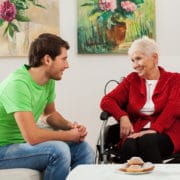3 Easy Pumpkin Crafts for Halloween and Thanksgiving
Here are three fun and easy craft projects to do by yourself, with friends, or while visiting with the grandkids.

Easy No-Sew Shirt Pumpkins
Just check the closet or some local thrift shops for shirts in fall colors and stripes or patterns. With a little stuffing, burlap, and twine, you can transform some old duds into new cute pumpkins decorations for Halloween or Thanksgiving. It’s a great alternative to carving pumpkins!
Check out this site for a list of items you’ll need and directions with detailed pictures: https://sewlicioushomedecor.com/free-easy-sew-and-no-sew-fabric-pumpkin-tutorials/
![]() Pumpkins from Toilet Paper Rolls
Pumpkins from Toilet Paper Rolls
So easy, inexpensive, and fast! Perfect for younger children. Takes only 5 minutes, boasts the author of this craft.
Essentially, you wrap a couple of plastic bags around and then tuck into the center of the toilet paper roll to give the ‘pumpkin’ some shape.
Then you wrap, pleat, and tuck some fabric and secure with a stick. A great way to keep some extra tissue on supply in the bath for guests, too!
Full instructions here: https://tinyurl.com/y4gm2sxx
3D Paper Pumpkin
Lastly, here’s a fun video that will show you have to create a 3D paper pumpkin with just some paper strips, glue, and pipe cleaners. It’s a great project to learn and teach the younger generations.
Whatever you do, we hope you have a very Happy (and safe) Halloween!!





